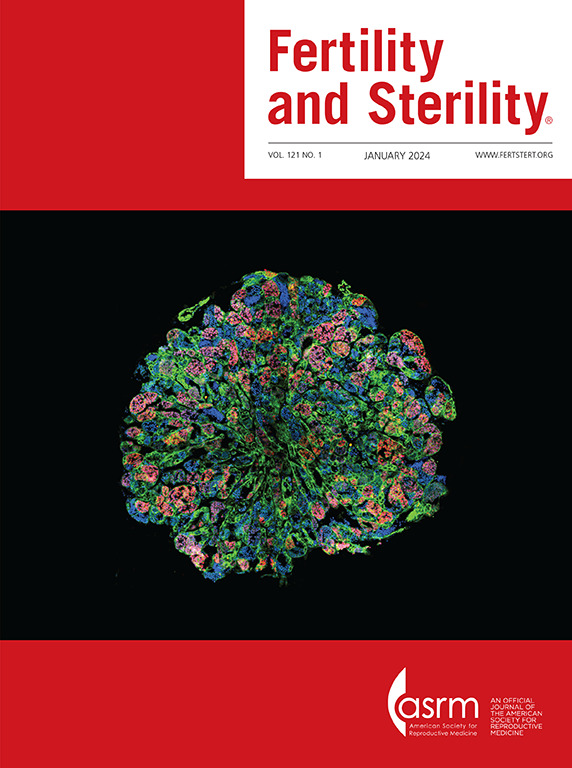Robotic-assisted excision of an accessory cavitated uterine malformation with indocyanine green assessment of the uterine cavity
IF 6.6
1区 医学
Q1 OBSTETRICS & GYNECOLOGY
引用次数: 0
Abstract
Objective
To highlight the presentation and management of a patient with dysmenorrhea caused by an accessory cavitated uterine malformation (ACUM) while also summarizing the current evidence regarding this pathology.
Design
Video article demonstrating the presentation, investigations, and surgical management of patient with an ACUM.
Subjects
A 22-year-old patient presenting with severe cyclical pain that was refractory to medical treatment was managed at a tertiary minimally invasive gynecology and endometriosis center. Ultrasound and magnetic resonance imaging showed radiological features consistent with ACUM. After appropriate counseling, the patient decided to proceed with surgical management.
Intervention
Robotic-assisted laparoscopic excision of an ACUM. The aim was to completely excise the malformation with specific steps taken to minimize blood loss, including infiltration with vasopressin and placement of temporary vascular clips, as well as prevent entry into the uterine cavity/fallopian tube. There was an incidental finding of endometriosis, which was also excised during the procedure.
Main Outcome Measures
Perioperative data, including complications, histology, and symptom change.
Results
Complete excision of malformation with uncomplicated procedure and recovery. Histology confirmed ACUM. At follow-up, the patient had complete resolution of presenting symptoms.
Conclusion
This video article highlights the presentation of patient with typical features for ACUM, as well as a reproducible technique for the surgical management of this malformation. The information can be used by other clinicians managing individuals with this rare presentation.
Escisión asistida por robot de una malformación uterina cavitada accesoria con evaluación de la cavidad uterina usando verde de indocianina
Objetivo
Resaltar la presentación y tratamiento de una paciente con dismenorrea causada por una malformación uterina cavitada accesoria (ACUM), y al mismo tiempo, resumir la evidencia actual sobre esta patología.
Diseño
Articulo en video que muestra la presentación, investigación y tratamiento quirúrgico de una paciente con ACUM.
Sujeto
Una paciente de 22 años que presentaba dolor cíclico severo que era refractario a tratamiento médico fue atendida en un centro terciario de ginecología y endometriosis mínimamente invasiva. La ecografía y resonancia magnética mostraron imágenes radiológicas compatibles con ACUM. Luego de un adecuado asesoramiento, la paciente decidió proceder con el tratamiento quirúrgico.
Intervención
Escisión laparoscópica de una ACUM por asistida por robot. El objetivo era extirpar por completo la malformación con pasos específicos para minimizar el sangrado, incluyendo la infiltración con vasopresina y la colocación temporal de clips vasculares, así como, prevenir la entrada en la cavidad uterina/trompas de Falopio. Se encontró endometriosis de manera incidental, que también fue extirpada durante el procedimiento.
Principal medida de resultado
Datos perioperatorios, incluyendo complicaciones, histología y cambios sintomáticos.
Resultados
Escisión completa de la malformación con procedimiento sin complicaciones y recuperación. La histología confirmó la presencia de ACUM. En el seguimiento, la paciente presentó una resolución completa de los síntomas presentados.
Conclusión
Este artículo en video destaca la presentación de un paciente con características típicas de ACUM, así como, técnica reproducible para el tratamiento quirúrgica de esta malformación. La información puede ser usada por otros médicos que traten a personas con esta rara presentación.
替换单个残基改变凝血酶的主要特异性。
背景:凝血酶倾向于在裂解位点(P1)携带Arg的底物,因为在初级特异性(S1)口袋中存在D189,但凝血酶也可以在P1位点切割携带Phe的底物。这种性质的结构基础是未知的。目的:研究凝血酶与P1位点携带Phe的配体结合的x射线结构,探讨替代D189的效果。方法:采用x射线晶体学方法对不可逆抑制剂h - d - ph - pro - ph - ch2cl (PPPCK)结合的凝血酶进行结构解析。残基D189突变为Ala、Lys、Phe和Ser。结果:以2.5 Å分辨率解析了凝血酶- pppck复合物的x射线结构,并与结合H-D-Phe-Pro-Arg-CH2Cl (PPACK)的凝血酶的结构进行了比较。PPPCK与凝血酶结合的构象与PPACK相似,但P1处的Phe与D189没有接触。将D189替换为Ala、Lys、Phe或Ser会逆转底物偏好和从精氨酸到Phe的稳定性增强。结论:S1口袋中的D189赋予凝血酶对Arg at P1的“胰蛋白酶样”特异性。然而,S1口袋足够宽,也使P1处的Phe具有“凝乳胰蛋白酶样”特异性。与这些结构特征相一致,单氨基酸替换(D189A)将凝血酶特异性从胰蛋白酶样转变为凝乳胰蛋白酶样,将底物偏好从h - d - ph - pro - arg -p-硝基苯胺转变为h - d - ph - pro - ph -p-硝基苯胺,并将优先稳定性从PPACK增强为PPPCK。凝血酶特异性主要由单个残基控制的发现在胰蛋白酶样蛋白酶领域建立了一个新的范例。
本文章由计算机程序翻译,如有差异,请以英文原文为准。
求助全文
约1分钟内获得全文
求助全文
来源期刊

Fertility and sterility
医学-妇产科学
CiteScore
11.30
自引率
6.00%
发文量
1446
审稿时长
31 days
期刊介绍:
Fertility and Sterility® is an international journal for obstetricians, gynecologists, reproductive endocrinologists, urologists, basic scientists and others who treat and investigate problems of infertility and human reproductive disorders. The journal publishes juried original scientific articles in clinical and laboratory research relevant to reproductive endocrinology, urology, andrology, physiology, immunology, genetics, contraception, and menopause. Fertility and Sterility® encourages and supports meaningful basic and clinical research, and facilitates and promotes excellence in professional education, in the field of reproductive medicine.
 求助内容:
求助内容: 应助结果提醒方式:
应助结果提醒方式:


